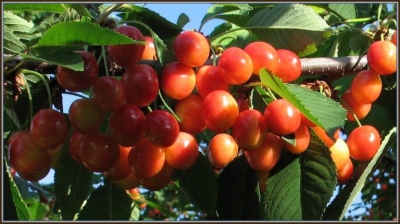
- Fruit shape: heart-shaped
- Authors: Belarus
- Growth type: medium-sized
- Yield: high
- Crown: wide pyramidal, raised, medium density
- Fruit size: large
- Fruit weight, g: 6,3
- Fruit color: main - yellow, integumentary - dark red
- Pulp color : yellow
- Pulp (consistency): juicy
Sweet cherry is a fruit crop with a high biological yield potential, but due to the environment in the annual development period, not every variety is able to realize its harvest. There are many varieties of sweet cherries, but the ideal variety that satisfies any request has not been bred, and its obtaining is the basic task of all breeding programs. Taking into account the high popularity and profitability of cherry cultivation, the most important directions in its selection are those that guarantee high yield, good marketability, long ripening and consumption of its fruits. More recently, scientists have managed to develop a variety called Gostinets.
Breeding history
The cherry owes its appearance to three Belarusian breeders - N. Kukharchik, M. Vyshinskaya, R. Sulimova. The hotel (in the Belarusian register of Gastinets) appeared as a result of crossing the varieties Aelita and Krasnaya dense. The official date of its appearance is 2005.
Description of the variety
The tree of this variety reaches a height of 4 to 5 meters. The crown has the shape of a pyramid and is raised high. Shoots do not grow densely, like leaves. The Gostinets bloom begins in April in the southern regions, in the middle lane - in early May. The flowers of this variety are large, snow-white, they grow in inflorescences of 3-5 pieces. The trees are self-fertile, so they will yield an annual harvest of dense and juicy berries. The hotel is frost-resistant, tolerating frosts down to -25 degrees. Fruiting already in the third or fourth year.
Fruit characteristics
The fruits of the Gostinets sweet cherry have a yellowish tint with a bright red blush. The berry weighs an average of 6.3 grams. The shape is round. The cherry has a small stone, it is easily separated from the yellow pulp. The Gostinets' skin is dense and has no taste.
Taste qualities
The hotel has earned very high marks from experts - 4.8 points out of 5. The fruits, indeed, have a rich sweet taste and characteristic aroma. They have a tonic effect on the body.
Ripening and fruiting
In the homeland of cherries, in Belarus, the process of maturation of the Gostinets begins in the first decade of July. In Russia, fruits begin to be harvested a little later, in August.

Yield
The hotel has a high yield. Without pollinators, you can harvest 300 quintals per hectare. However, the amount of the crop depends on both the pollinators and the growing region. In the southern regions, the number of harvested berries is greater.
Self-fertility and the need for pollinators
The tree itself is self-fertile, however, in the presence of other pollinating varieties, it gives a greater amount of yield, more than 300 centners / ha. Gardeners argue that it is best to choose Gronkovaya, Zhurba or Narodnaya as pollinators. There are secrets of good pollination: The hotel must be sprinkled with a solution of honey in advance. It is made at the rate of 1-2 tablespoons per liter of honey.
Growing and care
First you need to choose the best seedling of the Hotel. Preference should be given to proven nurseries that specifically deal with this variety. The age of the seedling should be a year or two, so they will take root faster and better. It is important to pay attention to the condition of the root. The rhizome must be clearly visible. The covering tissues of the Hotel are uniform, so you need to make sure that there are no blotches of dark shades.
Find the right place for the cherries. The hotel does not like drafts, prefers a lot of sunlight, even with a slight shade, it can grow poorly, the fruits will become small and savory. Groundwater should be 2 meters away from the seedling. Do not plant Gostinets on clayey, acidic soil. Deoxidation from dolomite flour and ash is suitable for wood. Limestone crushed stone and sand are used as drainage. Compost is suitable for fertilization; after applying it, you do not have to worry about feeding for three to four years. You can only occasionally add a little manure to the soil. The pit for the Hotel should be 80 centimeters in diameter and 80 centimeters deep. A peg is placed next to the cherry.
The hotel must be trimmed in early spring, forming a tiered shape in order to provide better illumination. It is also necessary to cut off dried, diseased branches. Cherry does not like excessive watering, it can begin to rot, since water displaces the necessary oxygen from the soil. It is very important to mulch the soil with peat. Sometimes birds like to feast on sweet Hotel. The only way to protect the fruit is to install a net.






Review overview
Although Gostinets is a relatively young variety compared to others, it is very loved by many amateur gardeners. They note the sweetness of the berries, their large size. However, some say that cherries often beat on the branches, resulting in ugly dark spots. The hotel deteriorates quite quickly, it needs to be eaten straight from the tree, it cannot withstand transportation. Everyone says that the variety requires a pollinator; without it, the tree gives no more than 40% of the possible yield. It is important, gardeners say, a well-chosen place and a lot of light.































































